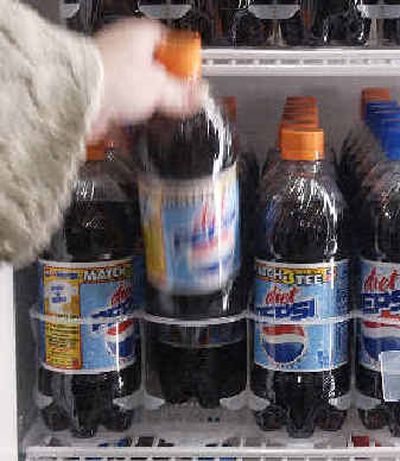More Americans thirst for something lighter

Still think the cola wars are about Coke vs. Pepsi?
These days the carbonated beverage battleground is diet vs. regular, and it’s looking increasingly as though the lightweight could flatten its full-calorie cousin.
Though the highly competitive $64 billion soft drink industry still is dominated by regular soda, sales of diet are surging and some industry analysts say low-cal eventually could take the lead.
That’s because while regular soda sales have sagged, diet’s share of the market has grown steadily since the mid-1990s. Bottled water, tea, sports and fruits drinks also are up, further siphoning regular soda sales.
In an obese nation obsessed with calories and carbs, it probably shouldn’t come as a surprise that people are switching to diet, and beverage companies are rushing to give them more choices.
In many ways the soft drink industry is better prepared than most others to capitalize on America’s perpetual diet.
“There’s no such thing as a no-calorie hamburger. There’s no such thing as a no-calorie doughnut,” said John Sicher, editor of Beverage Digest. “But the soft drink industry already has these huge powerful brands” of diet drinks.
Last year, regular soda accounted for nearly 73 percent of sales, but that was down nearly 2 percent from the year before, Sicher said. Meanwhile, diet was up more than 6 percent from 2002.
Sicher thinks that trend will continue and even accelerate enough that in a decade diet could outsell regular. He also thinks diet sales will spur overall growth in the soda industry, which slumped at less than 1 percent last year.
In fact, John Craven, editor of online beverage industry newsletter Bevnet.com, says soft drink consumption was down nearly 3 percent last year. If not for the growth in diet soda, that would have been closer to 10 percent.
Coca-Cola Co. spokesman Scott Williamson said Sicher makes sense assuming sales trends continue as they have. So what’s behind diet’s strong performance?
Calorie consciousness is a huge — and obvious — part of it. Prompted by a growing awareness of their growing waistlines, more people want low- and no-calorie soft drinks, said Sicher, who has followed the industry for 10 years.
That awareness also extends to retailers, who hope to attract dieters’ business by giving more — and more prominent — space to low-cal beverages, said Dan Dillon, vice president of marketing for Coke’s diet sodas.
Innovation has helped, too. Soda companies are churning out a stunning variety of new diet flavors. PepsiCo Inc. alone offers nearly a dozen low-calorie sodas, which account for more than a quarter of the company’s business.
New sweeteners also have broadened the appeal — and definition — of diet sodas. Coke and Pepsi now offer soft drinks with a blend of sugar and no-calorie sweetener, claiming the taste is similar to regular but with half the calories.
Growth and greater appeal or not, not everyone is convinced diets will surpass regular. Harry Balzer of consumer research firm NPD Group says the numbers simply don’t support that sort of abrupt turnaround.